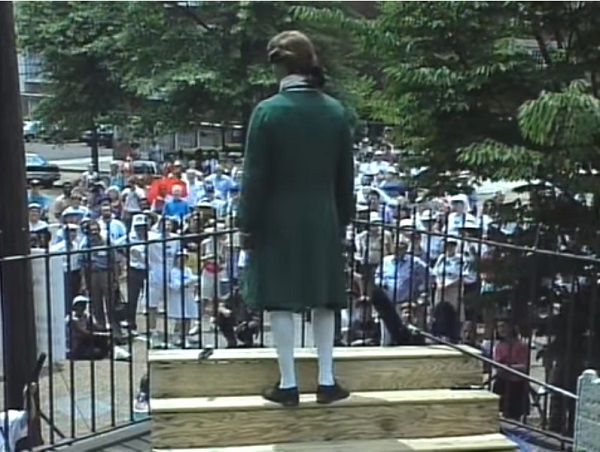By Michael McQuillan
In June 1993 the Richmond-based Hope in the Cities conducted a pioneering “Unity Walk” in what was once the Confederate capital and then a source of massive resistance to court-ordered school integration.
“Healing the Heart of America,” a 27-minute documentary, depicts this event. In it, multiracial conference partners viewed the “hidden” historic sites of Richmond’s slave trade – from Manchester Docks where slave ships landed, to Lumpkin’s Jail where families were torn apart and sold at slave auctions, and the Virginia State Capitol’s now pastoral grounds where Jim Crow lynchings occurred. Actors portrayed the episodes of these and other places. Facilitated discussions later led to collective renunciations of past and present injustice with vows to confront Richmond’s then-current social needs.
Conference coordinator Rob Corcoran wrote twenty years later in the Richmond Times-Dispatch that “while the original Unity Walk was largely the result of grassroots action, today the full telling of our history is promoted by the city’s Slave Trail Commission and our universities, museums and faith communities.” Police-Community Roundtables at the University of Virginia, a Black History Museum and Cultural Center, and the municipal Office of Community Wealth Building were ongoing products of Richmond’s racial trust-building process. A broad-based event supporting Richmond’s Muslim residents against threatening campaign rhetoric and testimony for racially-fair school funding during City Council hearings also proved strong bonds had formed.
Richmond’s “dialogue, action and change” effort contrasts with the conventional race discourse pattern of black rage and white denial. “Basic principles,” Corcoran says, “are start with yourself, bring everyone to the table, ask what my own group has done to preserve problems, and ask the other group what it needs to hear from my group for trust to exist.” “The commitment to honor our many different stories, no matter how conflicted, is at the heart of Richmond’s healing,” he adds.
The “national conversation” on policing and race that launched with Trayvon Martin’s death in Florida and escalated with events in Ferguson and elsewhere assigns blame or frames policies. Its participants compete to put forth “the” solution when many steps forward are needed. The exchange stumbles along without reaching resolution or even new ground because it avoids the conciliatory emotional sharing that made Richmond successful.
Has anyone offered an apology, let alone been accountable, for the endless sequence of death? George Zimmerman auctioned off the gun that shot Trayvon Martin! An undisclosed buyer paid $138,900 for the weapon, with Zimmerman showing no remorse, The Daily Beast reported Media coverage addressed whether police violence victims elsewhere were complicit in their own demise; Had Michael Brown in Ferguson robbed a convenience store? Was Freddy Gray in Baltimore too rowdy to be buckled into the van? Didn’t Eric Garner on Staten Island by selling loose cigarettes break a law?
Confession, forgiveness and reconciliation are integral in religious traditions of Muslims, Jews and Christians yet to our detriment nonexistent in civic affairs. “Where one or more sides in a political conflict has suffered traumatic historic or current losses whose depth and tragedy have not been acknowledged or atoned for by the side that caused the losses,” writes George Mason University Professor Joseph Montville, head of its Diplomacy and Conflict Resolution Program, “the wounds do not heal. They can be five, fifty or five hundred years old. We learned that time does not heal wounds. Only healing does.” In cities across the country that void is unfilled.
We would put Corcoran’s and Montville’s insights to use in New York, for example, if police personnel and community delegates would tour “pride and pain” places from both sides’ perspectives.
An itinerary could include the state-of-the-art Police Academy in Queens, the Joint Operations Center and Memorial Wall within NYPD headquarters at One Police Plaza, and the sites where Officers Rafael Ramos, Wenjian Liu and Brian Moore were killed. Places where they and their colleagues saved endangered citizens , aided the distressed or bonded with youth would be also appropriate — along with the “Underground Railroad Tour” at Plymouth Church of the Pilgrims in Brooklyn Heights, the Brooklyn Historical Society’s abolition exhibit with its authenticEmancipation Proclamation copy, the preserved first free African-American community at Weeksville and the original Bridge Street AME Church in Downtown Brooklyn where Frederick Douglass spoke and which honored Harriet Tubman. Medgar Evers College in Crown Heights, the Billie Holliday or Black Spectrum Theatres and the Restoration Corporation in Bedford-Stuyvesant, anchors of their urban areas, would be other parts of the path, with where Abner Louima, Akai Gurley and Ramarley Graham suffered police violence and where protests occurred. Those staging a pilot encounter could replicate it in New York’s other boroughs and assist other cities. Cleveland Mayor Frank Jackson, Chicago’s Rahm Emanuel and New York’s Bill de Blasio separately pledged under duress that their police departments would become “national models.” The Unity Walk is their unique opportunity.
New NYPD Commissioner James P. O’Neill, formerly Chief of Department, a 30-year veteran cop and Brooklyn native, enjoys rank and file loyalty with Mayoral support. This political capital could position O’Neill to act boldly, endorsing the project, inviting prominent figures to join him as an example for the city at large. The NYPD’s Neighborhood Coordinating Officers and its Community Partners Program, among his stated priorities, could facilitate and join in the event – and why not now?
The Justice Department recently released its 163-page finding of systemic police abuse in Baltimore. A Milwaukee police shooting last weekend unleashed long-dormant rage at the neglect of minorities’ needs for affordable housing and jobs, mere weeks since we mourned Alton Sterling, Philando Castile and the police officers in Dallas and Baton Rouge. We continue to argue semantics as to whether “Black,” “Blue” or “All” lives matter but we’d better wake up and try something different.
“Our social ethics are so out of norm that in the midst of all that is going on we miss the facts that underemployment, wealth disparity and our spiritual state have everyone being led by fear rather than by hope,” Hope in the Cities’ Reverend Sylvester “Tee” Turner observes. Harmony clichés and incremental police training improvements won’t save us.
With more than twenty cities under Federal Consent Decrees to monitor and reform police behavior why not a Unity Walk? The black rage-white denial cycle over racism has a fearsome emotional intensity that makes folks play it safe while stuck in stalemate. Frustration breeds anger, anger lashes out, adversaries retreat, frustration resumes, the cycle endures.
Let’s learn from Richmond to think “beyond the box” where we are. If we’ll bridge the race barrier to walk together to places resonant with historical memories that touch emotions we’ll start talking about the issues that face us all and the work that we, in a spirit of community, can do to unite police and community as well as our cities at large.
Here’s the video:
Become a Harlem Insider!
By submitting this form, you are consenting to receive marketing emails from: Harlem World Magazine, 2521 1/2 west 42nd street, Los Angeles, CA, 90008, https://www.harlemworldmagazine.com. You can revoke your consent to receive emails at any time by using the SafeUnsubscribe® link, found at the bottom of every email. Emails are serviced by Constant Contact









